Export to Excel in WinForms DataGrid (SfDataGrid)
21 Jan 202524 minutes to read
SfDataGrid provides support to export data to excel. It also provides support for grouping, filtering, sorting, paging, unbound rows and stacked headers while exporting.
The following assemblies needs to be added for exporting to excel.
For NuGet package, have to install Syncfusion.DataGridExport.WinForms package.For more details refer this UG link
The SfDataGrid can be exported to excel by using the ExportToExcel extension method present in the Syncfusion.WinForms.DataGridConverter namespace.
using Syncfusion.WinForms.DataGridConverter;
var options = new ExcelExportingOptions();
var excelEngine = sfDataGrid.ExportToExcel(sfDataGrid.View, options);
var workBook = excelEngine.Excel.Workbooks[0];
workBook.SaveAs("Sample.xlsx");Imports Syncfusion.WinForms.DataGridConverter
Dim options = New ExcelExportingOptions()
Dim excelEngine = sfDataGrid.ExportToExcel(sfDataGrid.View, options)
Dim workBook = excelEngine.Excel.Workbooks(0)
workBook.SaveAs("Sample.xlsx")NOTE
SfDataGrid exports data to excel by using
XlsIO. You can referXlsIO documentation for manipulating exported work sheets.
Exporting Options
By default, actual value only will be exported to excel. This can be changed to export the display text by setting the ExportMode property as Text.
var options = new ExcelExportingOptions();
options.ExportMode = ExportMode.Text;
var excelEngine = sfDataGrid.ExportToExcel(sfDataGrid.View, options);
var workBook = excelEngine.Excel.Workbooks[0];
workBook.SaveAs("Sample.xlsx");Dim options = New ExcelExportingOptions()
options.ExportMode = ExportMode.Text
Dim excelEngine = sfDataGrid.ExportToExcel(sfDataGrid.View, options)
Dim workBook = excelEngine.Excel.Workbooks(0)
workBook.SaveAs("Sample.xlsx")Export Groups with Outlines
By default, all the groups in SfDataGrid will be exported in expanded state. The outlines can be enabled in excel based on groups by setting the AllowOutlining property as true in ExcelExportingOptions.
var options = new ExcelExportingOptions();
options.AllowOutlining = true;
var excelEngine = sfDataGrid.ExportToExcel(sfDataGrid.View, options);
var workBook = excelEngine.Excel.Workbooks[0];
workBook.SaveAs("Sample.xlsx");Dim options = New ExcelExportingOptions()
options.AllowOutlining = True
Dim excelEngine = sfDataGrid.ExportToExcel(sfDataGrid.View, options)
Dim workBook = excelEngine.Excel.Workbooks(0)
workBook.SaveAs("Sample.xlsx")
Exclude Columns while Exporting
By default, all the columns (including hidden columns) in SfDataGrid will be exported to Excel. In order to exclude some columns from exporting, use the ExcludeColumns field of the ExcelExportingOptions.
var options = new ExcelExportingOptions();
options.ExcludeColumns.Add("CustomerID");
options.ExcludeColumns.Add("ProductName");
var excelEngine = sfDataGrid.ExportToExcel(sfDataGrid.View, options);
var workBook = excelEngine.Excel.Workbooks[0];
workBook.SaveAs("Sample.xlsx");Dim options = New ExcelExportingOptions()
options.ExcludeColumns.Add("CustomerID")
options.ExcludeColumns.Add("ProductName")
Dim excelEngine = sfDataGrid.ExportToExcel(sfDataGrid.View, options)
Dim workBook = excelEngine.Excel.Workbooks(0)
workBook.SaveAs("Sample.xlsx")Here, the columns having CustomerID and ProductName asMappingName are excluded while exporting.
Excel Version
The excel version can be specified while exporting to Excel by using ExcelVersion property.
var options = new ExcelExportingOptions();
options.ExcelVersion = ExcelVersion.Excel2013;
var excelEngine = sfDataGrid.ExportToExcel(sfDataGrid.View, options);
var workBook = excelEngine.Excel.Workbooks[0];
workBook.SaveAs("Sample.xlsx");Dim options = New ExcelExportingOptions()
options.ExcelVersion = ExcelVersion.Excel2013
Dim excelEngine = sfDataGrid.ExportToExcel(sfDataGrid.View, options)
Dim workBook = excelEngine.Excel.Workbooks(0)
workBook.SaveAs("Sample.xlsx")Exporting Stacked Headers
The stacked headers can also be exported to excel by setting the ExportStackedHeaders property to true.
var options = new ExcelExportingOptions();
options.ExportStackedHeaders = true;
var excelEngine = sfDataGrid.ExportToExcel(sfDataGrid.View, options);
var workBook = excelEngine.Excel.Workbooks[0];
workBook.SaveAs("Sample.xlsx");Dim options = New ExcelExportingOptions()
options.ExportStackedHeaders = True
Dim excelEngine = sfDataGrid.ExportToExcel(sfDataGrid.View, options)
Dim workBook = excelEngine.Excel.Workbooks(0)
workBook.SaveAs("Sample.xlsx")Exporting Unbound Rows
The unbound rows can be exported to excel by setting the ExportUnboundRows property as true.
var options = new ExcelExportingOptions();
options = true;
var excelEngine = sfDataGrid.ExportToExcel(sfDataGrid.View, options);
var workBook = excelEngine.Excel.Workbooks[0];
workBook.SaveAs("Sample.xlsx");Dim options = New ExcelExportingOptions()
options = True
Dim excelEngine = sfDataGrid.ExportToExcel(sfDataGrid.View, options)
Dim workBook = excelEngine.Excel.Workbooks(0)
workBook.SaveAs("Sample.xlsx")Changing Start Row and Column Index while Exporting
The data can be exported to the specified row and column index in worksheet, by setting StartRowIndex and StartColumnIndex properties.
var options = new ExcelExportingOptions();
options.StartRowIndex = 3;
options.StartColumnIndex = 3;
var excelEngine = sfDataGrid.ExportToExcel(sfDataGrid.View, options);
var workBook = excelEngine.Excel.Workbooks[0];
workBook.SaveAs("Sample.xlsx");Dim options = New ExcelExportingOptions()
options.StartRowIndex = 3
options.StartColumnIndex = 3
Dim excelEngine = sfDataGrid.ExportToExcel(sfDataGrid.View, options)
Dim workBook = excelEngine.Excel.Workbooks(0)
workBook.SaveAs("Sample.xlsx")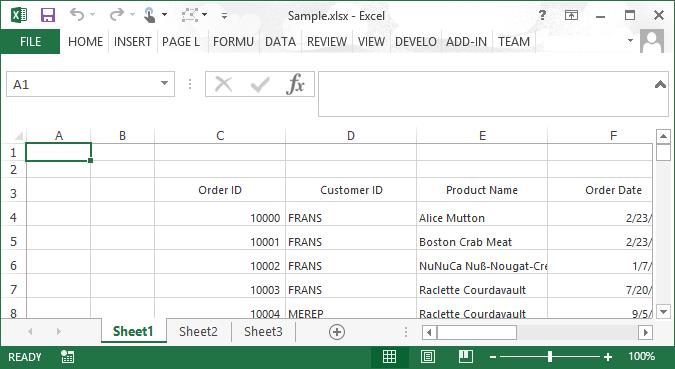
Saving Options
Save Directly to File
After exporting to excel the exported workbook can be saved directly to the file system by using SaveAs method.
var options = new ExcelExportingOptions();
var excelEngine = sfDataGrid.ExportToExcel(sfDataGrid.View, options);
var workBook = excelEngine.Excel.Workbooks[0];
workBook.SaveAs("Sample.xlsx");Dim options = New ExcelExportingOptions()
Dim excelEngine = sfDataGrid.ExportToExcel(sfDataGrid.View, options)
Dim workBook = excelEngine.Excel.Workbooks(0)
workBook.SaveAs("Sample.xlsx")Save as Stream
After exporting to excel the exported workbook can be saved to a stream by using SaveAs method.
var options = new ExcelExportingOptions();
options.ExcelVersion = ExcelVersion.Excel2013;
var excelEngine = sfDataGrid.ExportToExcel(sfDataGrid.View, options);
var workBook = excelEngine.Excel.Workbooks[0];
FileStream fileStream = new FileStream("Output.xlsx", FileMode.Create);
//Save to the file stream
workBook.SaveAs(fileStream);Dim options = New ExcelExportingOptions()
options.ExcelVersion = ExcelVersion.Excel2013
Dim excelEngine = sfDataGrid.ExportToExcel(sfDataGrid.View, options)
Dim workBook = excelEngine.Excel.Workbooks(0)
Dim fileStream As New FileStream("Output.xlsx", FileMode.Create)
'Save to the file stream
workBook.SaveAs(fileStream)Refer to the XlsIO documentation for further reference.
Save Using File Dialog
After exporting the SfDataGrid to excel, the exported workbook can be saved by opening the FileDialog.
var options = new ExcelExportingOptions();
options.ExcelVersion = ExcelVersion.Excel2013;
var excelEngine = sfDataGrid.ExportToExcel(sfDataGrid.View, options);
var workBook = excelEngine.Excel.Workbooks[0];
SaveFileDialog saveFilterDialog = new SaveFileDialog
{
FilterIndex = 2,
Filter = "Excel 97 to 2003 Files(*.xls)|*.xls|Excel 2007 to 2010 Files(*.xlsx)|*.xlsx|Excel 2013 File(*.xlsx)|*.xlsx"
};
if (saveFilterDialog.ShowDialog() == System.Windows.Forms.DialogResult.OK)
{
using (Stream stream = saveFilterDialog.OpenFile())
{
if (saveFilterDialog.FilterIndex == 1)
workBook.Version = ExcelVersion.Excel97to2003;
else if (saveFilterDialog.FilterIndex == 2)
workBook.Version = ExcelVersion.Excel2010;
else
workBook.Version = ExcelVersion.Excel2013;
workBook.SaveAs(stream);
}
//Message box confirmation to view the created workbook.
if (MessageBox.Show(this.sfDataGrid, "Do you want to view the workbook?", "Workbook has been created",
MessageBoxButtons.YesNo, MessageBoxIcon.Information) == DialogResult.Yes)
{
//Launching the Excel file using the default Application.[MS Excel Or Free ExcelViewer]
System.Diagnostics.Process.Start(saveFilterDialog.FileName);
}
}Dim options = New ExcelExportingOptions()
options.ExcelVersion = ExcelVersion.Excel2013
Dim excelEngine = sfDataGrid.ExportToExcel(sfDataGrid.View, options)
Dim workBook = excelEngine.Excel.Workbooks(0)
Dim saveFilterDialog As SaveFileDialog = New SaveFileDialog With {.FilterIndex = 2, .Filter = "Excel 97 to 2003 Files(*.xls)|*.xls|Excel 2007 to 2010 Files(*.xlsx)|*.xlsx|Excel 2013 File(*.xlsx)|*.xlsx"}
If saveFilterDialog.ShowDialog() = System.Windows.Forms.DialogResult.OK Then
Using stream As Stream = saveFilterDialog.OpenFile()
If saveFilterDialog.FilterIndex = 1 Then
workBook.Version = ExcelVersion.Excel97to2003
ElseIf saveFilterDialog.FilterIndex = 2 Then
workBook.Version = ExcelVersion.Excel2010
Else
workBook.Version = ExcelVersion.Excel2013
End If
workBook.SaveAs(stream)
End Using
'Message box confirmation to view the created workbook.
If MessageBox.Show(Me.sfDataGrid, "Do you want to view the workbook?", "Workbook has been created", MessageBoxButtons.YesNo, MessageBoxIcon.Information) = DialogResult.Yes Then
'Launching the Excel file using the default Application.[MS Excel Or Free ExcelViewer]
System.Diagnostics.Process.Start(saveFilterDialog.FileName)
End If
End IfExport Selected Items to Excel
By default, entire grid will be exported to Excel. The selected items can only exported to excel by passing the SelectedItems to the ExportToExcel method.
var options = new ExcelExportingOptions();
ExcelEngine excelEngine = new ExcelEngine();
IWorkbook workBook = excelEngine.Excel.Workbooks.Create();
workBook.Worksheets.Create();
sfDataGrid.ExportToExcel(sfDataGrid.SelectedItems, options, workBook.Worksheets[0]);
workBook.Version = ExcelVersion.Excel2013;
workBook.SaveAs("Sample.xlsx");Dim options = New ExcelExportingOptions()
Dim excelEngine As New ExcelEngine()
Dim workBook As IWorkbook = excelEngine.Excel.Workbooks.Create()
workBook.Worksheets.Create()
sfDataGrid.ExportToExcel(sfDataGrid.SelectedItems, options, workBook.Worksheets(0))
workBook.Version = ExcelVersion.Excel2013
workBook.SaveAs("Sample.xlsx")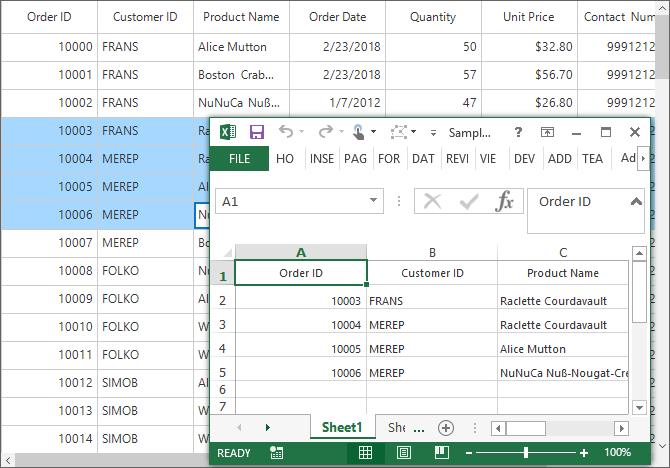
Export to HTML
The exported workbook can be saved as HTML by using SaveAsHtml method.
var options = new ExcelExportingOptions();
options.ExcelVersion = ExcelVersion.Excel2013;
var excelEngine = sfDataGrid.ExportToExcel(sfDataGrid.View, options);
var workBook = excelEngine.Excel.Workbooks[0];
workBook.SaveAsHtml("Sample.html", HtmlSaveOptions.Default);Dim options = New ExcelExportingOptions()
options.ExcelVersion = ExcelVersion.Excel2013
Dim excelEngine = sfDataGrid.ExportToExcel(sfDataGrid.View, options)
Dim workBook = excelEngine.Excel.Workbooks(0)
workBook.SaveAsHtml("Sample.html", HtmlSaveOptions.Default)It is also possible to save worksheet as HTML by using SaveAsHtml method. Also refer theXlsIO documentation for this.
Export to Mail
The SfDataGrid can be exported to mail by converting it into Excel and save exported worksheet as HTML. Then exported HTML contents is embedded in mail body.
var options = new ExcelExportingOptions();
options.ExcelVersion = ExcelVersion.Excel2010;
var excelEngine = sfDataGrid.ExportToExcel(sfDataGrid.View, options);
var workBook = excelEngine.Excel.Workbooks[0];
workBook.Worksheets[0].UsedRange.BorderInside(ExcelLineStyle.Thick, ExcelKnownColors.Black);
workBook.Worksheets[0].UsedRange.BorderAround(ExcelLineStyle.Thick, ExcelKnownColors.Black);
workBook.Worksheets[0].SaveAsHtml("test.htm", Syncfusion.XlsIO.Implementation.HtmlSaveOptions.Default);
System.Net.Mail.MailMessage myMessage = new System.Net.Mail.MailMessage();
myMessage.To.Add("[email protected]");
myMessage.From = new MailAddress("[email protected]");
myMessage.Priority = MailPriority.High;
myMessage.Subject = "Order Details";
myMessage.IsBodyHtml = true;
myMessage.Body = new StreamReader("test.htm").ReadToEnd();
SmtpClient client = new SmtpClient("smtp.office365.com", 587);
client.EnableSsl = true;
client.UseDefaultCredentials = false;
client.Credentials = new NetworkCredential("[email protected]", "test");
int count = 0;
while (count < 3)
{
try
{
client.Send(myMessage);
count = 3;
}
catch (Exception ex)
{
Console.WriteLine(ex.Message);
Console.WriteLine(String.Format("Sending Mail Attempt - {0}", count.ToString()));
Thread.Sleep(60000);
count++;
}
}
Console.WriteLine("Mail has been sent...");Dim options = New ExcelExportingOptions()
options.ExcelVersion = ExcelVersion.Excel2010
Dim excelEngine = sfDataGrid.ExportToExcel(sfDataGrid.View, options)
Dim workBook = excelEngine.Excel.Workbooks(0)
workBook.Worksheets(0).UsedRange.BorderInside(ExcelLineStyle.Thick, ExcelKnownColors.Black)
workBook.Worksheets(0).UsedRange.BorderAround(ExcelLineStyle.Thick, ExcelKnownColors.Black)
workBook.Worksheets(0).SaveAsHtml("test.htm", Syncfusion.XlsIO.Implementation.HtmlSaveOptions.Default)
Dim myMessage As New System.Net.Mail.MailMessage()
myMessage.To.Add("[email protected]")
myMessage.From = New MailAddress("[email protected]")
myMessage.Priority = MailPriority.High
myMessage.Subject = "Order Details"
myMessage.IsBodyHtml = True
myMessage.Body = New StreamReader("test.htm").ReadToEnd()
Dim client As New SmtpClient("smtp.office365.com", 587)
client.EnableSsl = True
client.UseDefaultCredentials = False
client.Credentials = New NetworkCredential("[email protected]", "test")
Dim count As Integer = 0
Do While count < 3
Try
client.Send(myMessage)
count = 3
Catch ex As Exception
Console.WriteLine(ex.Message)
Console.WriteLine(String.Format("Sending Mail Attempt - {0}", count.ToString()))
Thread.Sleep(60000)
count += 1
End Try
Loop
Console.WriteLine("Mail has been sent...")Export to XML
The exported workbook can also be saved as the xml file by using SaveAsXml method.
var options = new ExcelExportingOptions();
options.ExcelVersion = ExcelVersion.Excel2013;
var excelEngine = sfDataGrid.ExportToExcel(sfDataGrid.View, options);
var workBook = excelEngine.Excel.Workbooks[0];
workBook.SaveAsXml("Sample.xml", ExcelXmlSaveType.MSExcel);Dim options = New ExcelExportingOptions()
options.ExcelVersion = ExcelVersion.Excel2013
Dim excelEngine = sfDataGrid.ExportToExcel(sfDataGrid.View, options)
Dim workBook = excelEngine.Excel.Workbooks(0)
workBook.SaveAsXml("Sample.xml", ExcelXmlSaveType.MSExcel)Export to CSV
The exported workbook can be saved as CSV file by using the SaveAs method.
var options = new ExcelExportingOptions();
options.ExcelVersion = ExcelVersion.Excel2013;
var excelEngine = sfDataGrid.ExportToExcel(sfDataGrid.View, options);
var workBook = excelEngine.Excel.Workbooks[0];
workBook.SaveAs("Sample.csv", ",");Dim options = New ExcelExportingOptions()
options.ExcelVersion = ExcelVersion.Excel2013
Dim excelEngine = sfDataGrid.ExportToExcel(sfDataGrid.View, options)
Dim workBook = excelEngine.Excel.Workbooks(0)
workBook.SaveAs("Sample.csv", ",")Export to Image
It also possible to convert the exported excel file into Image without saving the excel file in system with the help of ConvertToImage method.
var excelExportingOptions = new ExcelExportingOptions();
ExcelEngine excelEngine = sfDataGrid.ExportToExcel(sfDataGrid.View, excelExportingOptions);
IWorkbook workbook = excelEngine.Excel.Workbooks[0];
IWorksheet sheet = workbook.Worksheets[0];
sheet.UsedRangeIncludesFormatting = false;
int lastRow = sheet.UsedRange.LastRow + 1;
int lastColumn = sheet.UsedRange.LastColumn;
System.Drawing.Image img = sheet.ConvertToImage(1, 1, lastRow, lastColumn, ImageType.Bitmap, null);
img.Save("Sample.png", ImageFormat.Png);
System.Diagnostics.Process.Start("Sample.png");Dim excelExportingOptions = New ExcelExportingOptions()
Dim excelEngine As ExcelEngine = sfDataGrid.ExportToExcel(sfDataGrid.View, excelExportingOptions)
Dim workbook As IWorkbook = excelEngine.Excel.Workbooks(0)
Dim sheet As IWorksheet = workbook.Worksheets(0)
sheet.UsedRangeIncludesFormatting = False
Dim lastRow As Integer = sheet.UsedRange.LastRow + 1
Dim lastColumn As Integer = sheet.UsedRange.LastColumn
Dim img As System.Drawing.Image = sheet.ConvertToImage(1, 1, lastRow, lastColumn, ImageType.Bitmap, Nothing)
img.Save("Sample.png", ImageFormat.Png)
System.Diagnostics.Process.Start("Sample.png")Import form Excel to SfDataGrid
The DataSource of the SfDataGrid can be imported from the excel sheet by using the IWorkSheet.ExportDataTable method. This method will convert the excel data into the DataTable.
ExcelEngine excelEngine = new ExcelEngine();
IApplication application = excelEngine.Excel;
application.DefaultVersion = ExcelVersion.Excel2013;
IWorkbook workbook = application.Workbooks.Create(1);
IWorksheet worksheet = workbook.Worksheets[0];
//Import the data to worksheet.
List<OrderInfo> reports = new List<OrderInfo>();
reports.Add(new OrderInfo() { OrderID = 1000, CustomerID = "FOLKO", OrderDate = DateTime.Now, ProductName = "Alice Mutton", Quantity = 10 });
worksheet.ImportData(reports, 1, 1, true);
//Read data from the worksheet and Export to the DataTable.
DataTable customersTable = worksheet.ExportDataTable(1, 1, 15, 5, ExcelExportDataTableOptions.ColumnNames);
this.sfDataGrid.DataSource = customersTable;
workbook.Close();
excelEngine.Dispose();Dim excelEngine As New ExcelEngine()
Dim application As IApplication = excelEngine.Excel
application.DefaultVersion = ExcelVersion.Excel2013
Dim workbook As IWorkbook = application.Workbooks.Create(1)
Dim worksheet As IWorksheet = workbook.Worksheets(0)
'Import the data to worksheet.
Dim reports As New List(Of OrderInfo)()
reports.Add(New OrderInfo() With {.OrderID = 1000, .CustomerID = "FOLKO", .OrderDate = DateTime.Now, .ProductName = "Alice Mutton", .Quantity = 10})
worksheet.ImportData(reports, 1, 1, True)
'Read data from the worksheet and Export to the DataTable.
Dim customersTable As DataTable = worksheet.ExportDataTable(1, 1, 15, 5, ExcelExportDataTableOptions.ColumnNames)
Me.sfDataGrid.DataSource = customersTable
workbook.Close()
excelEngine.Dispose()Row Height and Column Width Customization
After exporting data to excel, the row height and column width of the exported sheet can be set by using the SetRowHeight and SetColumnWidth methods.
var options = new ExcelExportingOptions();
var excelEngine = sfDataGrid.ExportToExcel(sfDataGrid.View, options);
var workBook = excelEngine.Excel.Workbooks[0];
workBook.Worksheets[0].SetRowHeight(2, 50);
workBook.Worksheets[0].SetColumnWidth(2, 50);
workBook.SaveAs("Sample.xlsx");Dim options = New ExcelExportingOptions()
Dim excelEngine = sfDataGrid.ExportToExcel(sfDataGrid.View, options)
Dim workBook = excelEngine.Excel.Workbooks(0)
workBook.Worksheets(0).SetRowHeight(2, 50)
workBook.Worksheets(0).SetColumnWidth(2, 50)
workBook.SaveAs("Sample.xlsx")Styling Cells based on CellType in Excel
The cell style of the exported excel sheet can be customized based on the CellType by using the Exporting event.
var options = new ExcelExportingOptions();
options.Exporting +=options_Exporting;
options.AllowOutlining = true;
var excelEngine = sfDataGrid.ExportToExcel(sfDataGrid.View, options);
var workBook = excelEngine.Excel.Workbooks[0];
workBook.SaveAs("Sample.xlsx");
void options_Exporting(object sender, Syncfusion.WinForms.DataGridConverter.Events.DataGridExcelExportingEventArgs e)
{
if (e.CellType == ExportCellType.HeaderCell)
{
e.CellStyle.BackGroundColor = Color.LightPink;
e.CellStyle.ForeGroundColor = Color.White;
e.Handled = true;
}
else if (e.CellType == ExportCellType.RecordCell)
{
e.CellStyle.BackGroundColor = Color.LightSkyBlue;
e.Handled = true;
}
else if (e.CellType == ExportCellType.GroupCaptionCell)
{
e.CellStyle.BackGroundColor =Color.Wheat;
e.Handled = true;
}
}Dim options As New ExcelExportingOptions()
AddHandler options.Exporting, AddressOf options_Exporting
options.AllowOutlining = True
Dim excelEngine = sfDataGrid1.ExportToExcel(sfDataGrid1.View, options)
Dim workBook = excelEngine.Excel.Workbooks(0)
workBook.SaveAs("Sample.xlsx")
Private Sub options_Exporting(ByVal sender As Object, ByVal e As Syncfusion.WinForms.DataGridConverter.Events.DataGridExcelExportingEventArgs)
If e.CellType = ExportCellType.HeaderCell Then
e.CellStyle.BackGroundColor = Color.LightPink
e.CellStyle.ForeGroundColor = Color.White
e.Handled = True
ElseIf e.CellType = ExportCellType.RecordCell Then
e.CellStyle.BackGroundColor = Color.LightSkyBlue
e.Handled = True
ElseIf e.CellType = ExportCellType.GroupCaptionCell Then
e.CellStyle.BackGroundColor = Color.Wheat
e.Handled = True
End If
End Sub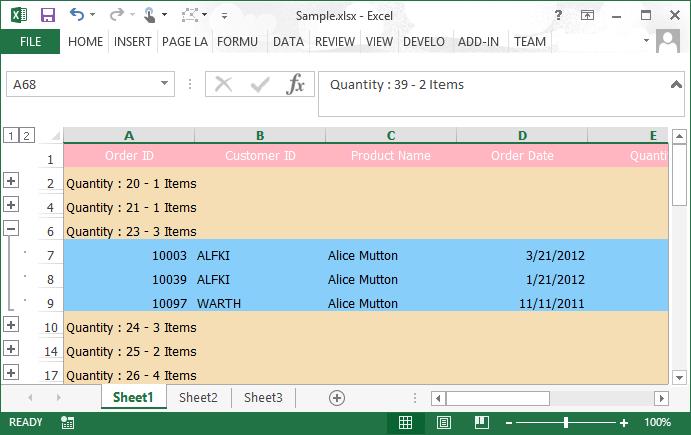
Cell Customization in Excel while Exporting
The cells can be customized on exporting by using the CellExporting event of the ExcelExportingOptions.
Customize Cell Value while Exporting
The cell value can be customized while exporting to excel by using the CellExporting event of the ExcelExportingOption.
var options = new ExcelExportingOptions();
options.CellExporting += CellExporting;
var excelEngine = sfDataGrid.ExportToExcel(sfDataGrid.View, options);
var workBook = excelEngine.Excel.Workbooks[0];
workBook.SaveAs("Sample.xlsx");
void CellExporting(object sender, Syncfusion.WinForms.DataGridConverter.Events.DataGridCellExcelExportingEventArgs e)
{
// Based on the column mapping name and the cell type, we can change the cell values while exporting to excel.
if (e.CellType == ExportCellType.RecordCell && e.ColumnName == "OrderID")
{
//if the cell value is Odd, "Y" will be displayed else "N" will be displayed.
if ((int)e.CellValue % 2 == 0)
e.Range.Cells[0].Value = "Y";
else
e.Range.Cells[0].Value = "N";
e.Handled = true;
}
}Dim options As New ExcelExportingOptions()
AddHandler options.CellExporting, AddressOf OnCellExporting
Dim excelEngine = sfDataGrid1.ExportToExcel(sfDataGrid1.View, options)
Dim workBook = excelEngine.Excel.Workbooks(0)
workBook.SaveAs("Sample.xlsx")
Private Sub OnCellExporting(ByVal sender As Object, ByVal e As Syncfusion.WinForms.DataGridConverter.Events.DataGridCellExcelExportingEventArgs)
'Based on the column mapping name and the cell type, we can change the cell values while exporting to excel.
If e.CellType = ExportCellType.RecordCell AndAlso e.ColumnName = "OrderID" Then
'if the cell value is Odd, "Y" will be displayed else "N" will be displayed.
If CInt(Fix(e.CellValue)) Mod 2 = 0 Then
e.Range.Cells(0).Value = "Y"
Else
e.Range.Cells(0).Value = "N"
End If
e.Handled = True
End If
End Sub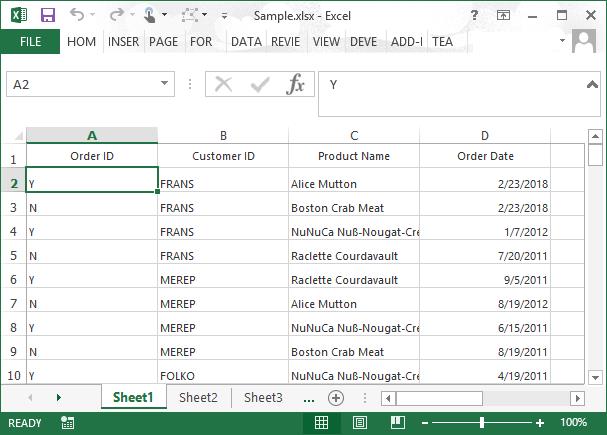
Changing Row style in Excel based on Data
The rows of the exported excel sheet can be customized based on the record value by using the CellExporting event.
var options = new ExcelExportingOptions();
options.CellExporting +=options_CellExporting;
var excelEngine = sfDataGrid.ExportToExcel(sfDataGrid.View, options);
var workBook = excelEngine.Excel.Workbooks[0];
workBook.SaveAs("Sample.xlsx");
private void options_CellExporting(object sender, Syncfusion.WinForms.DataGridConverter.Events.DataGridCellExcelExportingEventArgs e)
{
if (!(e.NodeEntry is OrderInfo))
return;
var record = e.NodeEntry as OrderInfo;
if (record.CustomerID == "FRANS")
{
e.Range.CellStyle.ColorIndex = ExcelKnownColors.Green;
e.Range.CellStyle.Font.Color = ExcelKnownColors.White;
}
}Dim options As New ExcelExportingOptions()
AddHandler options.CellExporting, AddressOf options_CellExporting
Dim excelEngine = sfDataGrid1.ExportToExcel(sfDataGrid1.View, options)
Dim workBook = excelEngine.Excel.Workbooks(0)
workBook.SaveAs("Sample.xlsx")
Private Sub options_CellExporting(ByVal sender As Object, ByVal e As Syncfusion.WinForms.DataGridConverter.Events.DataGridCellExcelExportingEventArgs)
If Not (TypeOf e.NodeEntry Is OrderInfo) Then
Return
End If
Dim record = TryCast(e.NodeEntry, OrderInfo)
If record.CustomerID = "FRANS" Then
e.Range.CellStyle.ColorIndex = ExcelKnownColors.Green
e.Range.CellStyle.Font.Color = ExcelKnownColors.White
End If
End Sub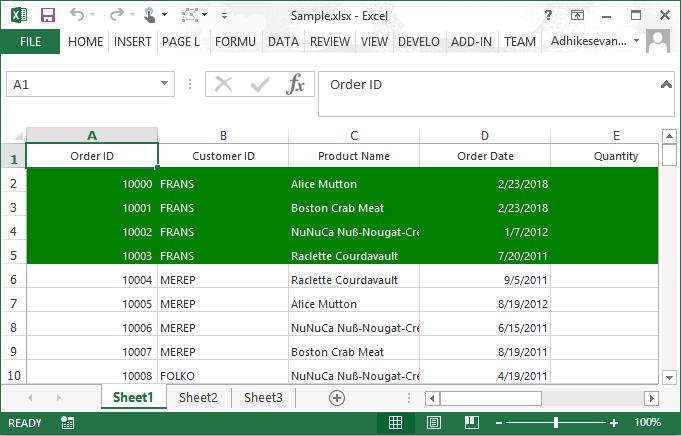
Customize Cells based on Column Name
The exported cells can be customized based on the column names by using the CellExporting event.
var options = new ExcelExportingOptions();
options.CellExporting += Options_CellExporting;
var excelEngine = sfDataGrid.ExportToExcel(sfDataGrid.View, options);
var workBook = excelEngine.Excel.Workbooks[0];
workBook.SaveAs("Sample.xlsx");
private void Options_CellExporting(object sender, Syncfusion.WinForms.DataGridConverter.Events.DataGridCellExcelExportingEventArgs e)
{
if (e.ColumnName != "OrderID")
return;
e.Range.CellStyle.Font.Size = 12;
e.Range.CellStyle.Font.Color = ExcelKnownColors.Pink;
e.Range.CellStyle.Font.FontName = "Segoe UI";
}Dim options As New ExcelExportingOptions()
AddHandler options.CellExporting, AddressOf options_CellExporting
Dim excelEngine = sfDataGrid1.ExportToExcel(sfDataGrid1.View, options)
Dim workBook = excelEngine.Excel.Workbooks(0)
workBook.SaveAs("Sample.xlsx")
Private Sub Options_CellExporting(ByVal sender As Object, ByVal e As Syncfusion.WinForms.DataGridConverter.Events.DataGridCellExcelExportingEventArgs)
If e.ColumnName <> "OrderID" Then
Return
End If
e.Range.CellStyle.Font.Size = 12
e.Range.CellStyle.Font.Color = ExcelKnownColors.Pink
e.Range.CellStyle.Font.FontName = "Segoe UI"
End Sub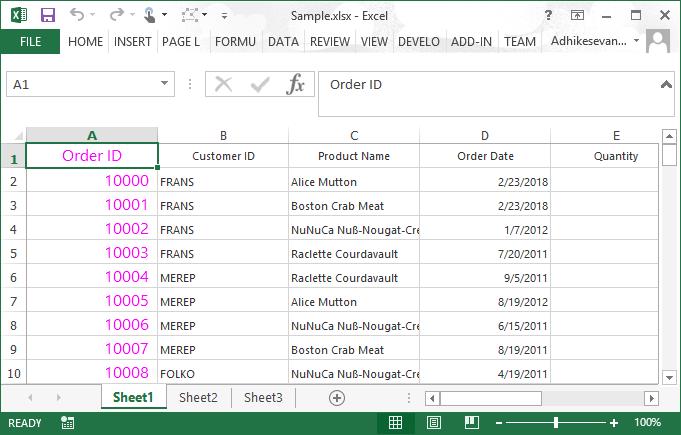
Here, OrderID column cells are customized while exporting.
Changing the border color of cells in Excel document
The border color of the cell will be customized when exporting to Excel by using the CellExporting event of the ExcelExportingOptions..
ExcelExportingOptions GridExcelExportingOptions = new ExcelExportingOptions();
GridExcelExportingOptions.CellExporting += OnCellExporting;
private void OnCellExporting(object sender, Syncfusion.WinForms.DataGridConverter.Events.DataGridCellExcelExportingEventArgs e)
{
//Set the border color for the excel cell
e.Range.BorderAround(ExcelLineStyle.Medium, ExcelKnownColors.Yellow);
}Dim GridExcelExportingOptions As New ExcelExportingOptions()
AddHandler GridExcelExportingOptions.CellExporting, AddressOf OnCellExporting
Private Sub OnCellExporting(ByVal sender As Object, ByVal e As Syncfusion.WinForms.DataGridConverter.Events.DataGridCellExcelExportingEventArgs)
'Set the border color for the excel cell
e.Range.BorderAround(ExcelLineStyle.Medium, ExcelKnownColors.Yellow)
End Sub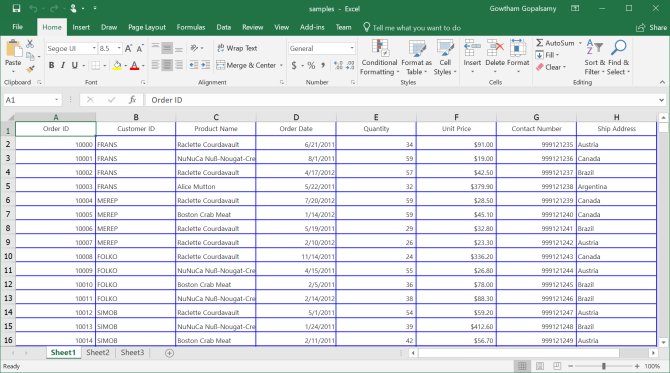
Customize Exported Workbook and Worksheet
SfDataGrid exports to excel by using XlsIO. The XlsIO documentation can also referred for manipulating workbook and sheet after exporting.
Workbook
SfDataGrid provides option to return ExcelEngine for getting the exported workbook. This allows to protect, encrypt and add worksheet before saving.
var options = new ExcelExportingOptions();
var excelEngine = sfDataGrid.ExportToExcel(sfDataGrid.View, options);
var workBook = excelEngine.Excel.Workbooks[0];
workBook.SaveAs("Sample.xlsx");Dim options = New ExcelExportingOptions()
Dim excelEngine = sfDataGrid1.ExportToExcel(sfDataGrid1.View, options)
Dim workBook = excelEngine.Excel.Workbooks(0)
workBook.SaveAs("Sample.xlsx")Worksheet Customization
SfDataGrid provides support to export to already existing file or worksheet. In the below code snippet, worksheet is created and passed to ExportToExcel method. In the same way, it can open the already existing excel also using XlsIO.
var options = new ExcelExportingOptions();
ExcelEngine excelEngine = new ExcelEngine();
IWorkbook workBook = excelEngine.Excel.Workbooks.Create();
sfDataGrid.ExportToExcel(sfDataGrid.View, options, workBook.Worksheets[0]);
workBook.Version = ExcelVersion.Excel2013;
workBook.SaveAs("Sample.xlsx");Dim options = New ExcelExportingOptions()
Dim excelEngine As New ExcelEngine()
Dim workBook As IWorkbook = excelEngine.Excel.Workbooks.Create()
sfDataGrid1.ExportToExcel(sfDataGrid1.View, options, workBook.Worksheets(0))
workBook.Version = ExcelVersion.Excel2013
workBook.SaveAs("Sample.xlsx")Before saving workbook, set the specific excel version by using IWorkbook.Version property. Here, you can directly manipulate the data in the worksheet. Also, referhere for more information about the worksheet customization.
Setting Borders
The borders of the excel cells can be set by directly accessing worksheet after exporting data.
var options = new ExcelExportingOptions();
options.ExcelVersion = ExcelVersion.Excel2013;
var excelEngine = sfDataGrid.ExportToExcel(sfDataGrid.View, options);
var workBook = excelEngine.Excel.Workbooks[0];
workBook.Worksheets[0].UsedRange.BorderInside(ExcelLineStyle.Dash_dot, ExcelKnownColors.Black);
workBook.Worksheets[0].UsedRange.BorderAround(ExcelLineStyle.Dash_dot, ExcelKnownColors.Black);
workBook.SaveAs("Sample.xlsx");Dim options As New ExcelExportingOptions()
options.ExcelVersion = ExcelVersion.Excel2013
Dim excelEngine = sfDataGrid1.ExportToExcel(sfDataGrid1.View, options)
Dim workBook = excelEngine.Excel.Workbooks(0)
workBook.Worksheets(0).UsedRange.BorderInside(ExcelLineStyle.Dash_dot, ExcelKnownColors.Black)
workBook.Worksheets(0).UsedRange.BorderAround(ExcelLineStyle.Dash_dot, ExcelKnownColors.Black)
workBook.SaveAs("Sample.xlsx")Enabling Filters
The filters can be shown in the exported worksheet by enabling the filter for the exported range of the worksheet.
var options = new ExcelExportingOptions();
options.ExcelVersion = ExcelVersion.Excel2013;
var excelEngine = sfDataGrid.ExportToExcel(sfDataGrid.View, options);
var workBook = excelEngine.Excel.Workbooks[0];
workBook.Worksheets[0].AutoFilters.FilterRange = workBook.Worksheets[0].UsedRange;
workBook.SaveAs("Sample.xlsx");Dim options As New ExcelExportingOptions()
options.ExcelVersion = ExcelVersion.Excel2013
Dim excelEngine = sfDataGrid1.ExportToExcel(sfDataGrid1.View, options)
Dim workBook = excelEngine.Excel.Workbooks(0)
workBook.Worksheets(0).AutoFilters.FilterRange = workBook.Worksheets(0).UsedRange
workBook.SaveAs("Sample.xlsx")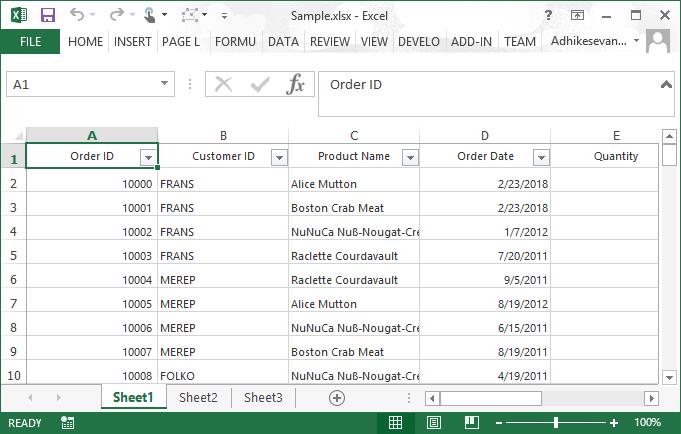
While using stacked headers, the range can be specified by based on stacked headers count.
var options = new ExcelExportingOptions();
options.ExcelVersion = ExcelVersion.Excel2013;
options.ExportStackedHeaders = true;
var excelEngine = sfDataGrid.ExportToExcel(sfDataGrid.View, options);
var workBook = excelEngine.Excel.Workbooks[0];
var range = "A" + (sfDataGrid.StackedHeaderRows.Count + 1).ToString() + ":" + workBook.Worksheets[0].UsedRange.End.AddressLocal;
excelEngine.Excel.Workbooks[0].Worksheets[0].AutoFilters.FilterRange = workBook.Worksheets[0].Range[range];
workBook.SaveAs("Sample.xlsx");Dim options As New ExcelExportingOptions()
options.ExcelVersion = ExcelVersion.Excel2013
options.ExportStackedHeaders = True
Dim excelEngine = sfDataGrid1.ExportToExcel(sfDataGrid1.View, options)
Dim workBook = excelEngine.Excel.Workbooks(0)
Dim range = "A" & (sfDataGrid1.StackedHeaderRows.Count + 1).ToString() & ":" & workBook.Worksheets(0).UsedRange.End.AddressLocal
excelEngine.Excel.Workbooks(0).Worksheets(0).AutoFilters.FilterRange = workBook.Worksheets(0).Range(range)
workBook.SaveAs("Sample.xlsx")Also refer the XlsIO document for more customization about the filtering.
Customizing the Range of Cells
The range of cells of the exported worksheet can be customized by directly manipulating worksheet.
var options = new ExcelExportingOptions();
options.ExcelVersion = ExcelVersion.Excel2013;
var excelEngine = sfDataGrid.ExportToExcel(sfDataGrid.View, options);
var workBook = excelEngine.Excel.Workbooks[0];
workBook.Worksheets[0].Range["A2:A6"].CellStyle.Color = System.Drawing.Color.LightSlateGray;
workBook.Worksheets[0].Range["A2:A6"].CellStyle.Font.Color = ExcelKnownColors.White;
workBook.SaveAs("Sample.xlsx");Dim options As New ExcelExportingOptions()
options.ExcelVersion = ExcelVersion.Excel2013
Dim excelEngine = sfDataGrid1.ExportToExcel(sfDataGrid1.View, options)
Dim workBook = excelEngine.Excel.Workbooks(0)
workBook.Worksheets(0).Range("A2:A6").CellStyle.Color = System.Drawing.Color.LightSlateGray
workBook.Worksheets(0).Range("A2:A6").CellStyle.Font.Color = ExcelKnownColors.White
workBook.SaveAs("Sample.xlsx")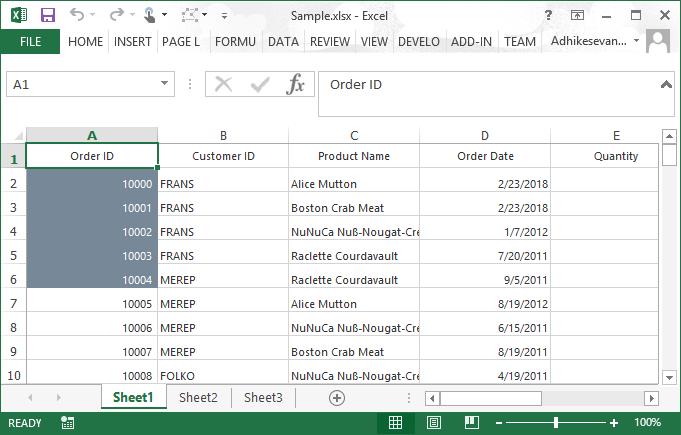
Exporting Multiple SfDataGrid to Single Excel Sheet
The multiple grids can also be exported to the same worksheet by using the UsedRange.CopyTo method.
var options = new ExcelExportingOptions();
options.ExcelVersion = ExcelVersion.Excel2010;
SfDataGrid sfDataGrid1 = new SfDataGrid();
sfDataGrid1.DataSource = new OrderInfoCollection().OrdersListDetails;
var excelEngine = sfDataGrid.ExportToExcel(sfDataGrid.View, options);
var workBook1 = excelEngine.Excel.Workbooks[0];
var worksheet1 = workBook1.Worksheets[0];
excelEngine = sfDataGrid1.ExportToExcel(sfDataGrid1.View, options);
var workBook2 = excelEngine.Excel.Workbooks[0];
var worksheet2 = workBook2.Worksheets[0];
var columnCount = sfDataGrid.Columns.Count;
//Merge the One SfDataGrid WorkSheet into the other SfDataGrid WorkSheet
worksheet2.UsedRange.CopyTo(worksheet1[1, columnCount + 1]);
workBook1.SaveAs("sample.xlsx");Dim options As New ExcelExportingOptions()
options.ExcelVersion = ExcelVersion.Excel2010
Dim sfDataGrid1 As New SfDataGrid()
sfDataGrid1.DataSource = New OrderInfoCollection().OrdersListDetails
Dim excelEngine = sfDataGrid1.ExportToExcel(sfDataGrid1.View, options)
Dim workBook1 = excelEngine.Excel.Workbooks(0)
Dim worksheet1 = workBook1.Worksheets(0)
excelEngine = sfDataGrid1.ExportToExcel(sfDataGrid1.View, options)
Dim workBook2 = excelEngine.Excel.Workbooks(0)
Dim worksheet2 = workBook2.Worksheets(0)
Dim columnCount = sfDataGrid1.Columns.Count
'Merge the One SfDataGrid WorkSheet into the other SfDataGrid WorkSheet
worksheet2.UsedRange.CopyTo(worksheet1(1, columnCount + 1))
workBook1.SaveAs("sample.xlsx")Performance
Using ExcelExportingOptions.CellExporting event and changing settings for each cell will consume more memory and time consumption. So, avoid using CellsExporting event and instead of that, do the required settings in the exported sheet.
Formatting Columns without using Event
The cell level customization such as row-level styling, formatting particular column can be performed in the exported worksheet.
In the below code snippet, NumberFormat for Unit Price column is changed in the exported sheet after exporting without using CellsExporting event.
var options = new ExcelExportingOptions();
options.ExportMode = ExportMode.Value;
options.ExcelVersion = ExcelVersion.Excel2013;
var excelEngine = sfDataGrid.ExportToExcel(sfDataGrid.View, options);
IWorkbook workBook = excelEngine.Excel.Workbooks[0];
workBook.ActiveSheet.Columns[5].NumberFormat = "0.0";
workBook.SaveAs("Sample.xlsx");Dim options As New ExcelExportingOptions()
options.ExportMode = ExportMode.Value
options.ExcelVersion = ExcelVersion.Excel2013
Dim excelEngine = sfDataGrid1.ExportToExcel(sfDataGrid1.View, options)
Dim workBook As IWorkbook = excelEngine.Excel.Workbooks(0)
workBook.ActiveSheet.Columns(5).NumberFormat = "0.0"
workBook.SaveAs("Sample.xlsx")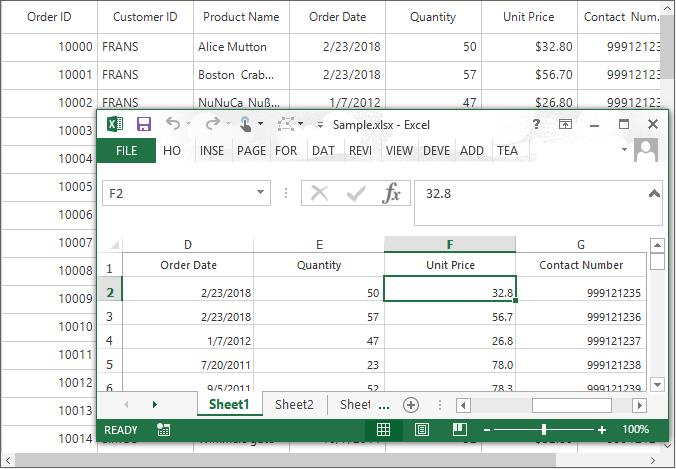
Alternate Row Styling without using the Event
In the below code snippet, the background color of rows in excel is changed based on row index using conditional formatting for better performance.
var options = new ExcelExportingOptions();
options.ExportMode = ExportMode.Value;
options.ExcelVersion = ExcelVersion.Excel2013;
var excelEngine = sfDataGrid.ExportToExcel(sfDataGrid.View, options);
IWorkbook workBook = excelEngine.Excel.Workbooks[0];
IConditionalFormats condition = workBook.ActiveSheet.Range[2, 1, this.sfDataGrid.View.Records.Count + 1, this.sfDataGrid.Columns.Count].ConditionalFormats;
IConditionalFormat condition1 = condition.AddCondition();
condition1.FormatType = ExcelCFType.Formula;
condition1.FirstFormula = "MOD(ROW(),2)=0";
condition1.BackColorRGB = System.Drawing.Color.Pink;
IConditionalFormat condition2 = condition.AddCondition();
condition2.FormatType = ExcelCFType.Formula;
condition2.FirstFormula = "MOD(ROW(),2)=1";
condition2.BackColorRGB = System.Drawing.Color.LightGray;
workBook.SaveAs("Sample.xlsx");Dim options As New ExcelExportingOptions()
options.ExportMode = ExportMode.Value
options.ExcelVersion = ExcelVersion.Excel2013
Dim excelEngine = sfDataGrid1.ExportToExcel(sfDataGrid1.View, options)
Dim workBook As IWorkbook = excelEngine.Excel.Workbooks(0)
Dim condition As IConditionalFormats = workBook.ActiveSheet.Range(2, 1, Me.sfDataGrid1.View.Records.Count + 1, Me.sfDataGrid1.Columns.Count).ConditionalFormats
Dim condition1 As IConditionalFormat = condition.AddCondition()
condition1.FormatType = ExcelCFType.Formula
condition1.FirstFormula = "MOD(ROW(),2)=0"
condition1.BackColorRGB = System.Drawing.Color.Pink
Dim condition2 As IConditionalFormat = condition.AddCondition()
condition2.FormatType = ExcelCFType.Formula
condition2.FirstFormula = "MOD(ROW(),2)=1"
condition2.BackColorRGB = System.Drawing.Color.LightGray
workBook.SaveAs("Sample.xlsx")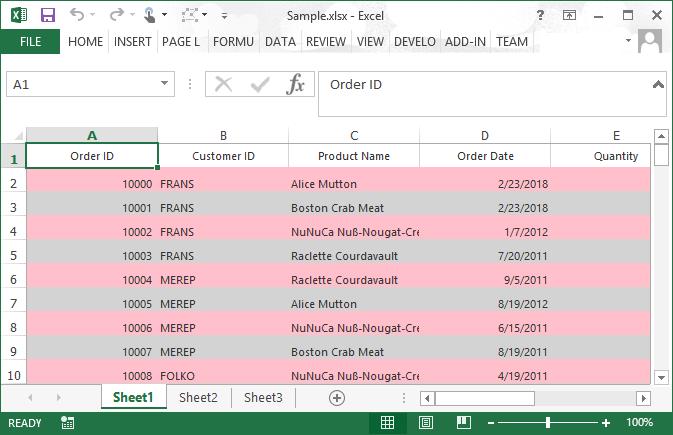
Refer the XlsIO document for the conditional customization.
See also
How to change the row height for the exported excel sheet in WinForms DataGrid (SfDataGrid)